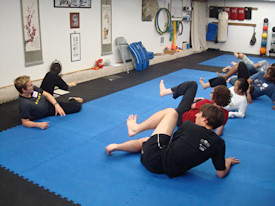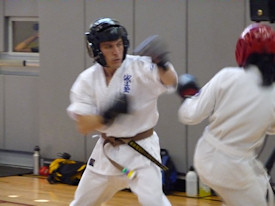2020 February
2018 December August June February
2017 December September June March
2016 November August June March
2015 December October July May February
2014 December October July April February
2013 December October August May February
2012 December September July April February
2011 December September July April February
from the February, 2011 issue of Kiai!
Is Karate for Self-Defense?
by Ryan Libel
“Ready stance is for beginners; later, one stands in natural stance.” – Gichin Funakoshi Sensei
“The more skills and choices an individual defender has, the more responsibility they have to solve whatever problem arises with minimum harm to the aggressor.” – Jun Shihan Nancy Lanoue
People choose to pursue martial arts for many reasons, but one of the most common is an idea that a martial pursuit, such as Seido Karate, will increase our ability to defend ourselves from physical harm. Similarly, at Thousand Waves, many students have become Seido Karate members after taking our violence prevention courses to further build their self-defense skills.
 Before long, however, it becomes clear to all of us at white belt that the practical elements of self-defense do not include many of our bread and butter karate techniques – our trusty tsukis and geris, we are told, are not so trusty after all, and are not the best self-defense weapons. Karate weapons take time to master. Instead, we develop an approach to self-defense that is much more conceptual. The “Think, Yell, Run, Fight, Tell” model of self-defense we espouse is not rooted in Seido Karate; it is rooted in the feminist empowerment model of self-defense.
Before long, however, it becomes clear to all of us at white belt that the practical elements of self-defense do not include many of our bread and butter karate techniques – our trusty tsukis and geris, we are told, are not so trusty after all, and are not the best self-defense weapons. Karate weapons take time to master. Instead, we develop an approach to self-defense that is much more conceptual. The “Think, Yell, Run, Fight, Tell” model of self-defense we espouse is not rooted in Seido Karate; it is rooted in the feminist empowerment model of self-defense.
Beyond the conceptual, even after we have exhausted our range of options for the peaceful resolution/ prevention of a conflict, the physical techniques of self-defense we teach are quite different from those we practice in dojo sparring. A palm heel strike to the nose is my personal favorite self-defense strike – but it’s nowhere to be found in our karate pre-sparring combinations. Spear-hand to the eye is another great one, similarly off-limits in sparring! The differences are so important to us that it is one topic about which we are required to write as we promote along the kyu path at Thousand Waves.
Another requirement is that we take our four-week self-defense course by the time we reach green belt. Believe me that it’s not because we’re after the course fees! The reason for the requirement is precisely the topic of this article – self-defense and Seido Karate are separate things.
Except when they aren’t. I persisted in my view of the virtual wall between karate and self-defense, as I briefly lay out above, until I began actively training to be a self-defense instructor at Thousand Waves a little over a year ago. Interestingly, and likely not coincidentally, it was also shortly after the time I tested for my shodan in Seido Karate. After practicing karate for close to 7 years now, I realize that the wall between the two pursuits is starting to crumble.
 In a dangerous attack situation, why on earth would I not attempt to deploy a peaceful joint lock from our karate curriculum to restrain an attacker? I’ve had over six years of practice with some of these locks by now! At the same time, readers struggling to learn Yakusoku Kumite #2, or “Basic” (that’s a hoot) Self-Defense #6 know well that those finishing joint locks are not techniques we can deploy reliably against a real-world attacker after a just few months of practice.
In a dangerous attack situation, why on earth would I not attempt to deploy a peaceful joint lock from our karate curriculum to restrain an attacker? I’ve had over six years of practice with some of these locks by now! At the same time, readers struggling to learn Yakusoku Kumite #2, or “Basic” (that’s a hoot) Self-Defense #6 know well that those finishing joint locks are not techniques we can deploy reliably against a real-world attacker after a just few months of practice.
The ethic of least harm that governs our practice at Thousand Waves implies, in my view, a constant re-appraisal of our own, individual capabilities for self-defense – that’s what Jun Shihan Nancy’s quote above is all about. Briefly, the idea is that while we believe strongly in our right to defend ourselves and others with physical force, we will do so with a view of doing as little physical harm to the assailant as possible.
When I began my training at Thousand Waves, I had not considered what I would do in a physical self-defense situation much at all, so I decided to try to internalize a response. My first line of defense was one that we teach in our four-week course: Get off the line, palm heel strike anything available on the head, and run away.
That was my first self-defense “ready stance,” as used by Funakoshi Sensei in the quote above. I needed it to ground my conception of physical self-defense situations. Over time, my “ready stance” has become more “natural.” In my first few years of training, that work on changing mostly happened in the “Think, Yell, Run” portion of the self-defense practice I was learning. The “Fight” portion of the stance I had internalized took the longest to change. Nearly seven years into my practice of both Self-Defense and Seido Karate, my stance still includes that initial getting off the line component. But beyond that it’s much more conceptual than concrete. Over time, I have increased my belief in my capabilities with some joint locks, and I now include some of them in my internalized line of physical defense. Along those lines, I believe that in a real-world situation I would actually avoid using many of the techniques I’m now teaching in our self-defense course. The techniques are great because they work – it doesn’t require much training to palm-heel a nose. It requires quite a bit more to force someone to the ground and hold them there until help arrives.
So what’s the point? For now, I’m pretty sure that a beautiful Seido Karate jump spinning hook kick is never going to be the best weapon to deploy in a physical self-defense situation. But let’s not rule it out completely, provided we’ve been practicing with it for a few decades first and the right (but very wrong) situation presents itself.
